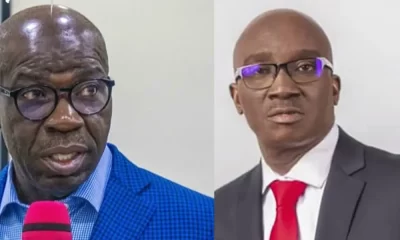Comments and Issues
Connecting 4 Global Education Trends locally
Published
8 years agoon
By
Olu Emmanuel
Hope is being able to see that there is light despite all of the darkness. Desmond Tutu
As a scientist, I am constantly beguiled by trends. I constantly use them to make predictions and also determine which way my work should lean towards. In education of late, I have seen four recent trends and while this is normally done at the end of the year or towards the beginning of the year, I decided to go off the beaten path and let’s have a mental deconstruct about these trends as we draw close to the first quarter of 2018.
Through my research I have noticed that they are already redefining K–12 education and this is something to be taken seriously in our climes locally. Follow along as I clarify them for you.
Trend 1: Paper-based textbooks are vanishing.
Of late, I have looked around and noticed that at an educational technological summit, most of the exhibitors who were in the ed-tech space all had some type of tablet gizmo that had textbooks and etc on them. You see, textbooks will soon be gone with the wind. I foresee textbooks being replaced by these tablets all around. The paper-based textbook industry is cutting their losses regrouping to put out digital content.
Reflection-: This is a great concern to our students in Nigeria, we are still using textbooks; albeit old ones whose content is outdated and irrelevant for the time in which we live in. How do we make this transition to getting with the program like the rest of the world is?
Trend 2: Digital curricula is rising.
There is an increasing demand for teachers to have on request curriculum to help them create engaging content. The digital curriculum industry is emerging. For example Open resource marketplaces (e.g., gooru, Edmodo, CK12) continue to expand (Amazon is about to open Inspire), while organizations that provide full curricula are beginning to hit their stride (e.g., EngageNY, Open Up).
Reflection -: This is something that must be addressed head on; learning is going digital and efforts need to be made in Nigeria to enable our students join this revolution.
Trend 3: Ready access to a computing device is the new normal.
In most classes in the US and in the UK; it is normal for there to be a “1-to-1″ — a classroom where each student has his/her own computing device. There have also been definitive, meta-study (a study of other studies) that finds solid experimental evidence for the noteworthy benefits for student achievement in ” appropriate ” 1-to-1 classrooms. (“appropriate” means that proper curriculum, proper instruction, proper time-on-task, etc., etc. were employed. This is no surprise to us; 1-to-1 is impactful!)
Project Tomorrow, an organization that has been collecting national (and international) data on technology in education since 2004, published a list of “Ten Things Everyone Should Know about K–12 Students’ Digital Learning.” Two “things” are critical here:
No. 2, Students of today are truly hooked on Mobile tech: Personal access to mobile devices has reached significant strides with over 80% of teenagers using smartphones now
No. 10, Goodbye 1-to-1! Different tasks = different tools! Laptops top students’ list for writing a report, taking online tests and working on group projects. Smartphones are No. 1 for connecting with classmates and accessing social media.
Reflection -: The smartphone revolution took Nigeria by surprise. I do see a lot of good coming from it though. Each smartphone is the equivalent of a computer these days- they perform most of the same tasks and students can be taught to use them effectively. It is easier for students to gain access to a smartphone than a laptop or desktop computer in low income areas.
Trend 4: integrating emotions in learning (neuroscience and education),
There is a noticeable interest in Neuroscience. The purpose of this specialty is to guide education professionals to design more suitable instructional models that allow a more well-adjusted development of the brain of children and adolescents, attending to the cognitive, emotional and social.
Neuroscience teaches us that: “A good emotional adaptability is essential to properly control and integrate learning processes.” More focus on teaching problem solving, in decision making, thinking critically and going beyond just increasing knowledge or information.
Reflection-: Over and over, I realize that holistic education is the ultimate goal. Neuroscience is a great enabler of holistic education. Our goal should be to produce students who are well balanced and add value to society.
These trends give me hope that though we have a long way to catch up with the world- by taking determined steps, we can equip students who can compete in the global space.
Adetola Salau; Educator / Speaker / Author/ Social Entrepreneur / Innovator
She is an Advocate of STEM Education and is Passionate about Education reform. She is an innovative thinker and strives for our society & continent as a whole to reclaim it’s greatness. She runs an educational foundation with the mission to transform education.
E-mail-:[email protected]
facebook-: Carisma4u
twitter-: @Carisma4u
Website-: www.carisma4u.com
Trending

 Business1 week ago
Business1 week agoGoogle announces N3bn investment to boost Nigeria’s AI talent, digital safety infrastructure

 Latest4 days ago
Latest4 days agoTinubu appoints Christopher Musa new Defence minister

 Latest5 days ago
Latest5 days agoObaseki counters Okpebholo’s remarks, vows to enter Benin when ready

 Business5 days ago
Business5 days agoFG threatens tough sanctions on banks, financial firms aiding terrorism financing

 News4 days ago
News4 days agoBoI disbursed over N1.27trn to 14 sectors in 2024 – Official

 Crime5 days ago
Crime5 days agoPolice reinforce ban on commercial motorcycles, tricycle operations in Kano

 Business4 days ago
Business4 days agoNaira slips further as new month opens with renewed FX pressure

 Politics5 days ago
Politics5 days agoMutfwang on way to APC

